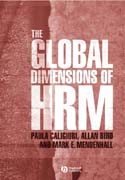
This short text takes on the principal issues involved in the management of aglobal workforce, and is designed as a useful guide for short executive courses. It features new, up-to-date coverage of several stages of global development for organizations. The authors present three ways to organize the HR Function world-wide; set out cross-border differences in employment laws; include 'the strategic global assignment process' - self-assessment of global competence; and conclude by mapping future developments in field. It represents a key text for undergraduates, MBA students, and management/HRM researchers alike. INDICE: International HRM.Paula Caligiuri, Allan Bird, and Mark Mendenhall. Introduction.Transnational Organizations: Their Structure, Growth, and the People Who Make Them Effective.- The Structure of Transnational Organizations.-Stages of Global Development for Organizations.- International Joint Venturesand Alliances. The Strategic HR Function in Transnational Organizations.- Administrative Global HR versus Strategic Global HR.- Three Ways to Organize the HR Function Worldwide.- The Strategy for Designing the HR Function Worldwide. The Context for Effectively Managing the Global Workforce.- Cross-Border Differences in Employment and Labor Laws. Numerical Flexibility (e.g., layoffs, working hours). Mandatory Benefits (e.g., healthcare contributions).- Cross-Border Differences in Workforce Competence.- Cross-Border Differences in Labor Economics.- Cross-Border Differences in Unions and Labor Relations. Cross-culturalDimensions Affecting Human Resource Management.- What is culture?.- Assessingculture for HRM.- Culture at Work (introduction to culture and cultural dimensions).- Relating Across Cultures. Hierarchical and Egalitarian Cultures. Formal and Informal Cultures. Group and Individually-Oriented Cultures. Building Trust Across Cultures. Transactional and Relational Cultures. How Work and Lifeare Balanced Across Cultures.- Communicating Across Cultures. High Context and Low Context Communications. Formal and Informal Communication Patterns. Expressive and Unemotional Communication Patterns.- Cultural Differences and Time.Controlled and Fluid Perceptions of Time. Past, Present and Future Orientations. Polychronic and Monochronic Time Management.- Cultural Differences in Management Styles. Giving Autonomy and Direction Across Cultures. Perceptions of Risk and Change Across Cultures. Perceptions of Diversity Across Cultures. Human Resource Practices for the Global Workforce.- Recruitment and Staffing.- Compensation and Benefits.- Training and Development.- Succession Planning.- Compensation and Benefits.- Global Leadership Development Programs.- Global Mobility. Types of Global Assignees. The Strategic Global Assignment Process.- Self-assessment.- Selection.- Cross-cultural Training.- Performance Management.- Repatriation.- Support Services. Human Challenges in the Global Organization.- Multinational teams.- Ethics.- Communication.- Negotiation.The Future of Global..
- ISBN: 978-1-4051-0731-0
- Editorial: Blackwell
- Encuadernacion: Rústica
- Páginas: 240
- Fecha Publicación: 22/06/2008
- Nº Volúmenes: 1
- Idioma: Inglés
